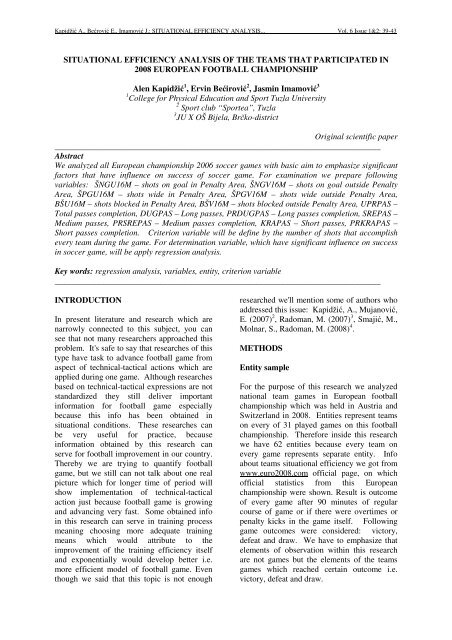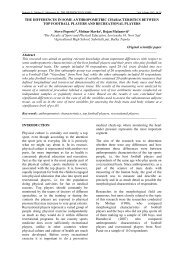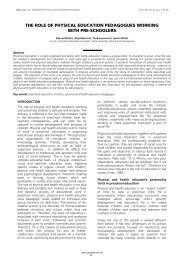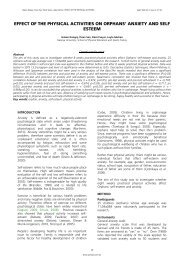SITUATIONAL EFFICIENCY ANALYSIS OF THE TEAMS THAT ...
SITUATIONAL EFFICIENCY ANALYSIS OF THE TEAMS THAT ...
SITUATIONAL EFFICIENCY ANALYSIS OF THE TEAMS THAT ...
You also want an ePaper? Increase the reach of your titles
YUMPU automatically turns print PDFs into web optimized ePapers that Google loves.
Kapidžić A., Bećrović E., Imamović J.: <strong>SITUATIONAL</strong> <strong>EFFICIENCY</strong> <strong>ANALYSIS</strong>... Vol. 6 Issue 1&2: 39-43<br />
<strong>SITUATIONAL</strong> <strong>EFFICIENCY</strong> <strong>ANALYSIS</strong> <strong>OF</strong> <strong>THE</strong> <strong>TEAMS</strong> <strong>THAT</strong> PARTICIPATED IN<br />
2008 EUROPEAN FOOTBALL CHAMPIONSHIP<br />
Alen Kapidžić 1 , Ervin Bećirović 2 , Jasmin Imamović 3<br />
1 College for Physical Education and Sport Tuzla University<br />
2 Sport club “Sportea”, Tuzla<br />
3 JU X OŠ Bijela, Brčko-district<br />
Original scientific paper<br />
______________________________________________________________________________<br />
Abstract<br />
We analyzed all European championship 2006 soccer games with basic aim to emphasize significant<br />
factors that have influence on success of soccer game. For examination we prepare following<br />
variables: ŠNGU16M – shots on goal in Penalty Area, ŠNGV16M – shots on goal outside Penalty<br />
Area, ŠPGU16M – shots wide in Penalty Area, ŠPGV16M – shots wide outside Penalty Area,<br />
BŠU16M – shots blocked in Penalty Area, BŠV16M – shots blocked outside Penalty Area, UPRPAS –<br />
Total passes completion, DUGPAS – Long passes, PRDUGPAS – Long passes completion, SREPAS –<br />
Medium passes, PRSREPAS – Medium passes completion, KRAPAS – Short passes, PRKRAPAS –<br />
Short passes completion. Criterion variable will be define by the number of shots that accomplish<br />
every team during the game. For determination variable, which have significant influence on success<br />
in soccer game, will be apply regression analysis.<br />
Key words: regression analysis, variables, entity, criterion variable<br />
______________________________________________________________________________<br />
INTRODUCTION<br />
In present literature and research which are<br />
narrowly connected to this subject, you can<br />
see that not many researchers approached this<br />
problem. It's safe to say that researches of this<br />
type have task to advance football game from<br />
aspect of technical-tactical actions which are<br />
applied during one game. Although researches<br />
based on technical-tactical expressions are not<br />
standardized they still deliver important<br />
information for football game especially<br />
because this info has been obtained in<br />
situational conditions. These researches can<br />
be very useful for practice, because<br />
information obtained by this research can<br />
serve for football improvement in our country.<br />
Thereby we are trying to quantify football<br />
game, but we still can not talk about one real<br />
picture which for longer time of period will<br />
show implementation of technical-tactical<br />
action just because football game is growing<br />
and advancing very fast. Some obtained info<br />
in this research can serve in training process<br />
meaning choosing more adequate training<br />
means which would attribute to the<br />
improvement of the training efficiency itself<br />
and exponentially would develop better i.e.<br />
more efficient model of football game. Even<br />
though we said that this topic is not enough<br />
researched we'll mention some of authors who<br />
addressed this issue: Kapidžić, A., Mujanović,<br />
E. (2007) 2 , Radoman, M. (2007) 3 , Smajić, M.,<br />
Molnar, S., Radoman, M. (2008) 4 .<br />
METHODS<br />
Entity sample<br />
For the purpose of this research we analyzed<br />
national team games in European football<br />
championship which was held in Austria and<br />
Switzerland in 2008. Entities represent teams<br />
on every of 31 played games on this football<br />
championship. Therefore inside this research<br />
we have 62 entities because every team on<br />
every game represents separate entity. Info<br />
about teams situational efficiency we got from<br />
www.euro2008.com official page, on which<br />
official statistics from this European<br />
championship were shown. Result is outcome<br />
of every game after 90 minutes of regular<br />
course of game or if there were overtimes or<br />
penalty kicks in the game itself. Following<br />
game outcomes were considered: victory,<br />
defeat and draw. We have to emphasize that<br />
elements of observation within this research<br />
are not games but the elements of the teams<br />
games which reached certain outcome i.e.<br />
victory, defeat and draw.
Kapidžić A., Bećrović E., Imamović J.: <strong>SITUATIONAL</strong> <strong>EFFICIENCY</strong> <strong>ANALYSIS</strong>... Vol. 6 Issue 1&2: 39-43<br />
Variable sample<br />
Variable in this research are features of game<br />
elements which were implemented by the<br />
teams during the game. These statistics<br />
indicators FIFA promotes for all competitions<br />
which are performed under FIFA tutorship.<br />
From all features that are analyzed and which<br />
are on official FIFA page, we analyzed<br />
following variables i.e. features: ŠNGU16M –<br />
shots on goal in Penalty Area, ŠNGV16M –<br />
shots on goal outside Penalty Area, ŠPGU16M<br />
– shots wide in Penalty Area, ŠPGV16M –<br />
shots wide outside Penalty Area, BŠU16M –<br />
shots blocked in Penalty Area, BŠV16M –<br />
shots blocked outside Penalty Area, UPRPAS<br />
– Total passes completion %, DUGPAS –<br />
Long passes, PRDUGPAS – Long passes<br />
completion %, SREPAS – Medium passes,<br />
Model<br />
1<br />
Regression<br />
Residual<br />
Total<br />
Model<br />
1<br />
By analyzing individual influence (Table 3),<br />
we can see that only one variable has<br />
statistically significant influence on criteria<br />
and that is variable ŠNGU16M – shots on goal<br />
in Penalty Area. Beta coefficient is .44 for<br />
Table 1<br />
Table 2<br />
b ANOVA<br />
PRSREPAS – Medium passes completion %,<br />
KRAPAS – Short passes, PRKRAPAS – Short<br />
passes completion %. These variables<br />
represented predictor system of variables.<br />
Criteria variable is defined by number of goals<br />
scored by each team: UKUPGO – Total goals<br />
scored.<br />
RESULTS AND DISCUSSION<br />
Based on results we got in Tables 1 and 2, you<br />
can see that multiple correlation i.e.<br />
correlation of predicting system with criteria is<br />
R .60, with total explained variability R<br />
Square .36%, which is on .50 significant level.<br />
These results tell us that whole system of<br />
predicting variables is significant in prediction<br />
of the criteria variable.<br />
47.355 13 3.643 2.078 .034 a<br />
Sum of<br />
Squares df Mean Square F Sig.<br />
84.145 48 1.753<br />
131.500 61<br />
a. Predictors: (Constant), BŠV16M, ŠNGU16M, PRDUGPAS, ŠPGV16M, BŠU16M,<br />
KRAPAS, ŠNGV16M, ŠPGU16M, SREPAS, UPRPAS, DUGPAS, PRKRAPAS,<br />
PRSREPAS<br />
b. Dependent Variable: UKUPGO<br />
Model Summary<br />
.600a Adjusted Std. Error of<br />
R R Square R Square the Estimate<br />
.360 .187 1.324<br />
a.<br />
Predictors: (Constant), BŠV16M, ŠNGU16M,<br />
PRDUGPAS, ŠPGV16M, BŠU16M, KRAPAS,<br />
ŠNGV16M, ŠPGU16M, SREPAS, UPRPAS, DUGPAS,<br />
PRKRAPAS, PRSREPAS<br />
above mentioned variable, which is on .01<br />
significant level. Also importance of this<br />
variable influence on criteria confirms T-test<br />
value which is 3.126.
Kapidžić A., Bećrović E., Imamović J.: <strong>SITUATIONAL</strong> <strong>EFFICIENCY</strong> <strong>ANALYSIS</strong>... Vol. 6 Issue 1&2: 39-43<br />
Model<br />
1<br />
(Constant)<br />
UPRPAS<br />
DUGPAS<br />
PRDUGPAS<br />
SREPAS<br />
PRSREPAS<br />
KRAPAS<br />
PRKRAPAS<br />
ŠNGU16M<br />
ŠNGV16M<br />
ŠPGU16M<br />
ŠPGV16M<br />
BŠU16M<br />
BŠV16M<br />
Unstandardized<br />
Coefficients<br />
a. Dependent Variable: UKUPGO<br />
Because only variable ŠNGU16M – shots on<br />
goal in Penalty Area, indicated statistically<br />
significant individual influence, and the rest of<br />
variables don't have statistically important<br />
individual influence, we have to find reasons<br />
why we've gotten these indicators. Info<br />
attained this way mean nothing without some<br />
deeper analysis, so to explain these reactions<br />
of predicting system with criteria we will do it.<br />
First of all to shoot on goal in penalty area, we<br />
have to realize all factors which are necessary<br />
to get to penalty area of opponent team, and<br />
then to shoot on goal. Shooting in football is<br />
also linked to intellect of the player. To shoot<br />
well adopted technique is not the only<br />
important thing but perceptive capabilities<br />
which arise at all technical elements, even so<br />
more at shooting. Perceptive capabilities<br />
represent mental process in which feelings and<br />
experience are closely connected, which<br />
means, that every perception contains feelings<br />
which is it based on. Accordingly players with<br />
more experience notice more details. That<br />
means that players remember all previous<br />
similar situations that they've found<br />
themselves in, and when in certain moment<br />
they find themselves in similar situation they<br />
compare these previous situations with the<br />
current one they're in. Information is requisite<br />
for adequate analysis like the following:<br />
positioning of the player with regards to goal,<br />
Table 3<br />
Coefficients a<br />
Standardized<br />
Coefficients<br />
B Std. Error Beta t Sig.<br />
4.064 1.614 2.518 .015<br />
-.005 .004 -.334 -1.392 .170<br />
.011 .023 .126 .481 .633<br />
-.004 .026 -.043 -.169 .866<br />
-.031 .024 -1.377 -1.272 .209<br />
.031 .026 1.358 1.177 .245<br />
-.009 .032 -.118 -.273 .786<br />
.005 .039 .052 .117 .908<br />
.299 .096 .443 3.126 .003<br />
.100 .084 .175 1.186 .241<br />
.013 .118 .016 .106 .916<br />
.001 .075 .002 .017 .986<br />
-.063 .207 -.039 -.307 .761<br />
.292 .170 .247 1.717 .092<br />
positioning of the opponent players in front of<br />
the ball if there are any, positioning of the<br />
goalkeeper on the goal etc., all this<br />
information player compares to previous<br />
experience and is choosing the best way of<br />
shooting. Thus acquired results can be<br />
compared to results acquired in a research of<br />
Kapidžić, A., Mujanović, E., Nožinović, F.<br />
(2006) 1 . In this research authors reached<br />
results which revealed that shot on goal has<br />
significant influence on success of the teams in<br />
games i.e. materialization of the utmost<br />
objective – victory.<br />
However, when we talk about shot on goal in<br />
penalty area, we have to say that very good<br />
shooting technique is needed for that. In order<br />
to shoot inside penalty area, very often we<br />
don't have enough time for the preparation of<br />
the shot i.e. establishing control, but shooting<br />
in most cases is executed from the first stroke.<br />
This way of shooting has a surprise effect<br />
because defense players don't have enough<br />
time to block a shot, and a goalkeeper has a<br />
very little time to position himself properly.<br />
Based on the results we can say that more<br />
successful teams in this championship had<br />
better individual and group tactics. By<br />
analyzing raw info we see that more successful<br />
teams had better number of total passes<br />
completion %, which tells us that teams have<br />
played through all three stadium areas
Kapidžić A., Bećrović E., Imamović J.: <strong>SITUATIONAL</strong> <strong>EFFICIENCY</strong> <strong>ANALYSIS</strong>... Vol. 6 Issue 1&2: 39-43<br />
(defense, middle and offense). Confirmation<br />
of this is research of Smajić, M., Molnar, S.,<br />
Radoman, M. (2008) 4 where author came to<br />
conclusion that difference between more<br />
successful teams and less successful teams is<br />
in ball activities. This game requires players<br />
with highly adopted technique which we won't<br />
discuss about here since all players have a<br />
high level of technical preparation. What<br />
separates players of more successful teams<br />
from the players of less successful teams are<br />
just individual and group tactics, because<br />
players have a good control over ball<br />
especially in offensive third, make good passes<br />
CONCLUSION<br />
From this research it's possible to obtain<br />
information to guide the process of preparing<br />
football players in our country, both, already<br />
established athletes as well as those in younger<br />
age groups. There are many reasons that may<br />
affect the results thus obtained, and it is<br />
impossible to number them all, but we have<br />
listed only those that we think are the most<br />
logical cause of the results thus obtained. For<br />
this research to have practical use especially in<br />
football in our country and not to stay only the<br />
theoretical discussion, we will list following<br />
suggestion by which should trainer go in work<br />
with football players for the better quality of<br />
their performance.<br />
1. Therefore, we suggest that in training<br />
process it's taken into account the development<br />
of the cognitive abilities of young football<br />
players, which obviously leads to achieving<br />
better results in the opportunistic-motor skills,<br />
where results of this research also implied for.<br />
Practice games on both goals on smaller part<br />
of stadium can be used for development of<br />
perceptive abilities, then practice on smaller<br />
field with limited number of contacts with ball<br />
etc.<br />
2. More experienced trainers should work<br />
with young athletes just because kids in this<br />
period of life are the most flexible for certain<br />
changes and if some mistakes are made then<br />
later it's very hard or almost impossible to<br />
correct them.<br />
3. Young football players have to adopt well<br />
football technique, but should more and more<br />
apply and perfect that technique in situational<br />
conditions.<br />
4. The major problem in Bosnia and<br />
Herzegovina (BH) football is a great delay in<br />
under pressure and have a good sense for<br />
running in the blank space for reception. It's<br />
certain that more successful teams on this<br />
championship had a technique which was<br />
more orientated on concept of the game then<br />
the teams that were less successful. This says<br />
that more successful teams had players which<br />
had better level of creativity. Results achieved<br />
in research of Kapidžić,A., Mujanović, E.<br />
(2007) 2 are in favour of such discussion, where<br />
authors concluded that teams that had more<br />
creative players had more success in played<br />
games.<br />
application of scientific achievements for the<br />
purpose of gaining excellent results, and<br />
therefore we believe that this work may be a<br />
small contribution to the promotion of football<br />
in our country.<br />
5. Analysis of some matches at the European<br />
and world level, and based on the PRO-ZONE<br />
program, shows that the players during one<br />
game have an average speed of 2 m/s. When<br />
at that speed they have to implement any<br />
technical element, not even to mention the<br />
pressure of opponent players that tells us about<br />
level of technical readiness of these players.<br />
This can be achieved only if in competition<br />
period we pay great attention to training<br />
technique but also in situation conditions.<br />
Finally we must say that the top success is<br />
only possible if the process of athletes<br />
preparation and sport itself is based on<br />
scientifically based tendencies, and that's<br />
probably the only and right way to direct our<br />
league competition according to contemporary<br />
acquisitions of football game.
LITERATURE<br />
1. Kapidžić, A., Mujanović, E., Nožinović, F. (2006). Analiza igre u nogometu na svjetskom<br />
prvenstvu 2006 godine. Nacionalni naučni skup sa međunarodnim učešćem FIS<br />
KOMUNIKACIJE, str. 37-41. Niš. [2006 football world championship game analysis.<br />
National scientific meeting with international participation FIS COMMUNICATIONS, pg.<br />
37-41. Niš.]<br />
2. Kapidžić, A., Mujanović, E. (2007). Razlike učinka između pobjedničkih i poraženih ekipa<br />
na svjetskom nogometnom prvenstvu 2006. Časopis za sport, fizičko vaspitanje i zdravlje<br />
SPORT MONT, broj 12, 13, 14 / V, str. 297-303. Podgorica. [Performance differences<br />
between winning and defeated teams on 2006 football world championship. Magazine for<br />
sport, physical education and health SPORT MONT, no. 12, 13, 14 / V, pg. 297-303.<br />
Podgorica.]<br />
3. Radoman, M. (2007). Evaluacija zvaničnih statističkih podataka FIFA World Cup-a u<br />
Nemačkoj 2006. godine. Magistarski rad, Fakultet za sport i turizam, Novi Sad. [Evaluation of<br />
official statics FIFA World Cup in Germany 2006. year. Master thesis, College for sport and<br />
tourism, Novi Sad.]<br />
4. Smajić, M., Molnar, S., Radoman, M. (2008). The differences between winning and defeated<br />
football team while performing various activities with a ball. SPORT SCIENTIFIC &<br />
PRACTICAL ASPECTS. Vol. 5, str 7-12.<br />
5. Smajić, M., Molnar, S. (2006). Razlike između pobjedničkih i poraženih ekipa u elementu<br />
primanja lopte. In Analitika i dijagnostika fizičke aktivnosti, str. 126-134. Fakultet za tjelesni<br />
odgoj i sport, Beograd. [The differences between winning and defeated teams in element of<br />
receiving a ball. In analytics and diagnostics of physical activity, pg. 126-134. College for<br />
physical education and sport, Beograd.]<br />
ANALIZA SITUACIONE EFIKASNOSTI TIMOVA KOJI SU UČESTVOVALI NA<br />
EVROPSKOM FUDBALSKOM PRVENSTVU 2008.<br />
Originalni naučni rad<br />
______________________________________________________________________________<br />
Sažetak<br />
Sa ciljem određivanja značajnih faktora koji ujteču na uspjeh igre u nogometu analizirali smo sve<br />
utakmice sa evropskog nogometnog prvenstva 2006 godine. Za istraživanje primjenili smo slijedeće<br />
varijable: ŠNGU16M – šut u okvir vrata unutar 16 metara, ŠNGV16M – šut u okvir vrata izvan 16<br />
metara, ŠPGU16M – šut van okvira vrata unutar 16 metara, ŠPGV16M – šut van okvira vrata izvan<br />
16 metara, BŠU16M – blokiran šut unutar 16 metara, BŠV16M – blokiran šut izvan 16 metara,<br />
UPRPAS – ukupno preciznih pasova, DUGPAS – dugi pasovi, PRDUGPAS – precizni dugi pasovi,<br />
SREPAS – pasovi na srednja rastojanja, PRSREPAS – precizni pasovi na srednja rastojanja, KRAPAS<br />
– pasovi na malim rastojanjima, PRKRAPAS – precizni pasovi na malim rastojanjima. Kriterijska<br />
varijabla bit će definisana na osnovu broja pogodaka koje je postigla svaka ekipa u utakmici. Za<br />
određivanje varijabli koje imaju značajan utjecaj na uspjeh igre u nogometu bit će primjenjena<br />
multipla regresiona analiza.<br />
Ključne riječi: regresiona analiza, varijable, entitet, kriterijska varijabla<br />
______________________________________________________________________________<br />
Correspondent:<br />
Alen Kapidžić, Ph.D.<br />
Tuzla University,<br />
Faculty of Physical Education and Sport<br />
2. Oktobra 1,<br />
75 000 Tuzla, Bosnia and Herzegovina<br />
Phone: +387 35 278 535<br />
E-mail: alen.kapidzic@untz.ba





